Is there anything good to say about today’s report from the Bureau of Labor Statistics that the U.S. unemployment rate jumped up to 6.1% while seasonally adjusted nonfarm payrolls declined by another 84,000 jobs? Well, here’s one thing. It gives us some real clarity as to just where the economy stands.

|
Sure looks like a recession when you inspect a graph the unemployment rate, doesn’t it? And it also looks like a recession from the perspective of a model of unemployment dynamics that I published in 2005. If you use that model to analyze the latest unemployment numbers, you’d calculate the current probability of being in a recession at 95%.
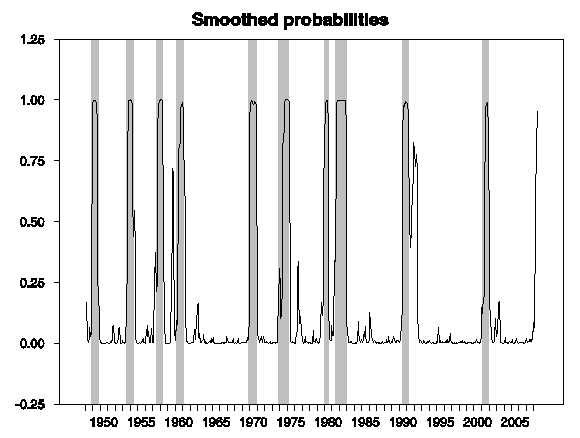
|
As I noted when I discussed that model last month, one reason that the above graph seems to be able to identify recessions so clearly is that it uses the full sample of data available today to infer what was the situation at each historical date. If instead you try to base a call only on the data available at the time, the inference is much choppier. Even so, a 95% probability is not likely to be a miss.
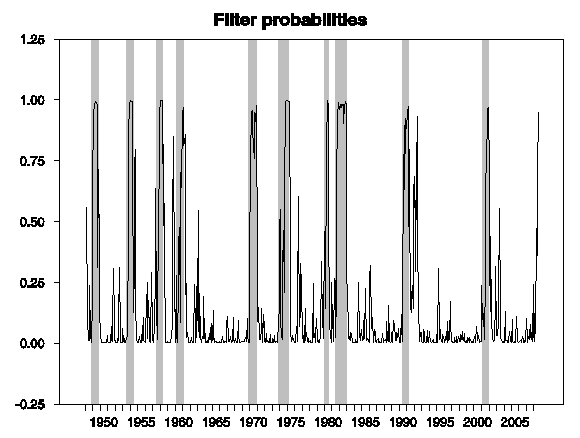
|
That model distinguishes between a mild recession and a severe recession, with the graphs above combining the two. In fact, the August unemployment report leads to a 14% probability that we just entered the “severe contraction” phase. The last time we had a one-month filter probability of that regime higher than that was October of 1982.
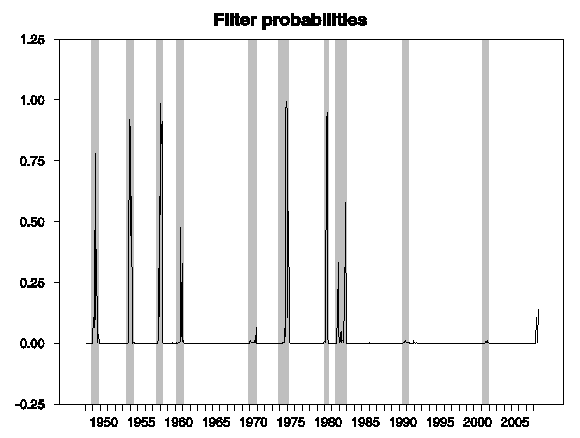
|
Last month I also discussed some thresholds for recognizing a recession recently proposed by
UCLA Professor Ed Leamer. Leamer says it usually means recession if the unemployment rate has jumped up by 0.8% within the last six months. When Leamer proposed that criterion two months ago, the 6-month increase of 0.5% seemed to leave us well short of the threshold. Today’s numbers imply a 6-month increase of 1.3%, shooting past it pretty definitively.
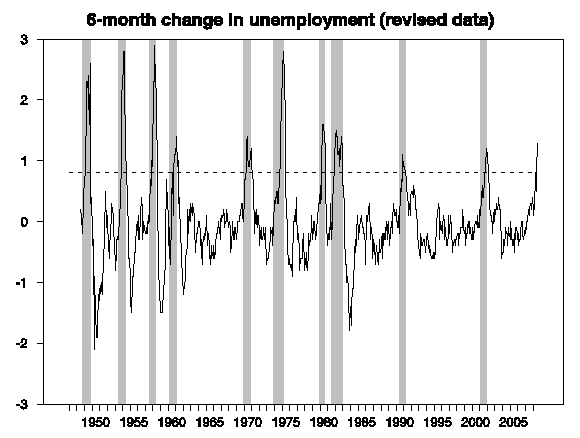
|
Leamer also said it would be a recession if the 6-month change in the measure of civilian employment based on the BLS household survey fell by more than 0.4%. Today’s number of -0.354% would technically fall short of that, if you’re determined to split hairs more finely than the allowable pixels in the graph below.
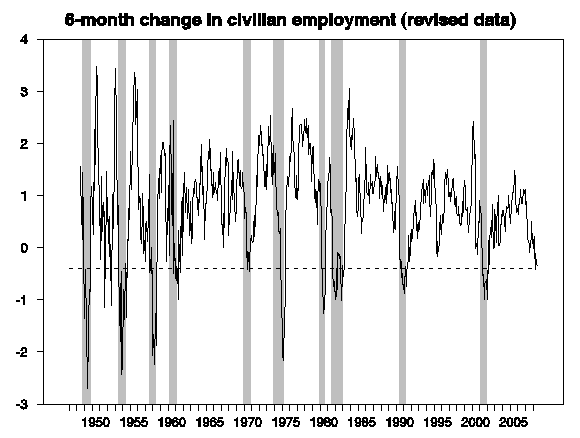
|
Finally, Leamer said he’d call it a recession if the 6-month change in nonfarm payrolls fell by over 0.5%. Today’s NFP report, while disappointing, still leaves us at only -0.3%. Whew! That was a close call, no?

|
No. I think we’re better off looking at the 12-month rather than 6-month change in nonfarm payrolls. And the 12-month change, now at -0.2%, is clearly a recession-type number:

|
And, by the way, calling it a recession when the 12-month change in nonfarm payrolls becomes negative appears to be pretty robust even given the revisions we know are likely to come in these data later.
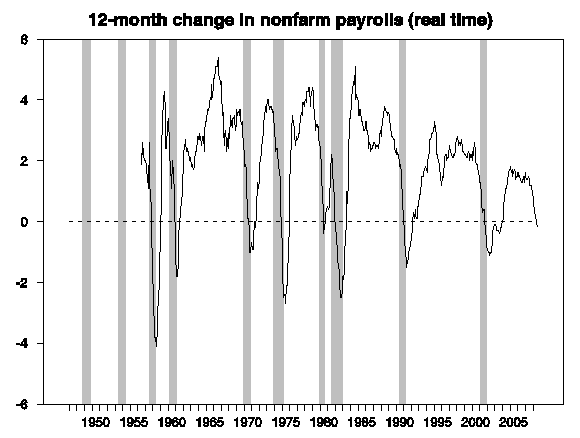
|
So I don’t see any way to slice today’s report other than to say, at least as far as the employment numbers are concerned, the U.S. is now definitely in a recession.
And if you won’t take my word for it, you can hear pretty much the same thing from
Brad DeLong,
Justin Fox,
William Polley,
Paul Krugman,
and the various economists quoted by WSJ Real Time.
Technorati Tags: employment,
recession probability,
recession indicator index,
macroeconomics,
economics
Jim,
Is there a coherent way to isolate the effects of the recent minimum wage hikes from the unemployment figures? I’d hate to think one of the primary reasons unemployment rates have tracked upward and tripped Leamer’s trigger is because minimum wage workers are being pushed out of the job market at disproportionately high rates.
That said, having scanned the latest employment situation report, it looks to me that we’re finally seeing broad-based job losses across multiple occupations – that’s serious, although we should note it’s a delayed response to earlier distressed economic conditions.
I would anticipate that we’ll be seeing a rise in mass layoffs, particularly in the automotive industry and sectors closely related to it, which are just now acting to respond to lost demand by permanently reducing their workforces.
Is there any reason to disbelieve that employment lags the economic cycle in this cycle? I think we may be closer to the end of the cycle than the beginning.
NYT is now reporting that Fannie/Freddie will be placed in conservatorship.
Let me put in a plug for one of your coauthors: Marcelle Chauvet has updated her recession model at http://www.faculty.ucr.edu/~chauvet/CREFC.htm.
Her model is a bit different; it aims to predict whether the NBER business cycle dating committee will call a recession. (This means it uses many indicators, not just employment.) She’s presently putting the odds at 63.5% that they will eventually declare a recession.
question is: how & when we’ll get out of this nasty mess???
A little bit of hope: Unemployment is raising, BUT along with Labor Productivity!
So, taking a longer term structural perspective, everything is not as bad as it seems now in this very moment.
This must be revealed to the public and should feed into agents’ expectations about future personal wealth. And if expecations prove reasonable, we’ll be out of the woods sooner than anticipated.
Ironman: I’d hate to think one of the primary reasons unemployment rates have tracked upward and tripped Leamer’s trigger is because minimum wage workers are being pushed out of the job market at disproportionately high rates.
Maybe, hard to tell. But I’ve had a close look at MW in the past few days,(discussed on Angry Bear) in terms of real buying power. The lowest effective value for MW since 1955 was in … 2006, when it had a value in 1996$ of $4.04. (DoL stats, I don’t know why they used 1996.) The chart is here: http://preview.tinyurl.com/5h4oyb . MW has bounced between $4 and $5 since the early 80s.
I suppose a boost of what is essentially pin money ($5.15 –> $5.85) to the lowest paid hourly workers might burden employers at the razor edge of solvency, but then anything — commodities, price of gasoline — would do the same. I don’t think McDonalds is that bad off.
WSJ has a piece today http://tinyurl.com/5cgwvu mentioning McDonald’s profits would have fallen off last quarter, but for currency shifts, and they with many other food producers are responding to commodity prices by fiddling with new cheaper ingredients. WSJ Aug 22. But no mention in major media about the minimum wage effecting their profits.
Noni
Noni – thanks for your insights. I think it’s a mistake to focus upon McDonald’s in any discussion of minimum wage hike effects, as the company doesn’t rely upon a minimum wage earning workforce for its competitive advantages. That lack of reliance also helps insulate the company from the effects of minimum wage hikes – it simply wouldn’t see the same kinds of increased labor costs that the Mom & Pop owned small businesses that predominantly hire workers at the minimum wage experience.
Merci SvN.
Overall, it looks like the noisy stock markets managed to predict this apparent recession though I suspect that more stock market “toilet flushing” lies ahead. Valuations are still high by historic standards; current solid balance sheets are no guarantee of future solid balance sheets.
Now for a model that usefully predicts recession duration…. To the caribou shoulder blades! Or another look at yield curve tea-leaf reading? I understand the source of your optimism BR but fear it may be misplaced.
Noni Mausa and Ironman: It is amusing to think that McDonalds pays its workers efficiency wages. Not comforting, just amusing.
Thanks Ironman, I hadn’t known that.
Noni
GNP said: “It is amusing to think that McDonalds pays its workers efficiency wages. Not comforting, just amusing.”
😉 You made my day!
I’m convinced, Doc, that we’re in recession.
And, yes, a ‘severe contraction phase’ is underway, absolutely. Given the ridiculously high household debt/GDP ratio — unprecedented — this downturn is going to be a long, ugly one.
I’m glad (snark) that Treasury and The Fed is working so hard to save the banks and brokers and schmucks like Pimco.
Huh? McDonald’s national median wage for line workers is less than the minimum wage in most states and only a few cents higher than the federal rate. How does this demonstrate that they are unaffected by minimum wage law?
benamery21: The data I linked to for McDonalds’s applies to the period prior to the latest series of minimum wage increases at both the state and federal level. As such, McDonald’s has a big enough margin between what it has been paying and the mandated minimum wage level to have only experienced a minimal impact from those increases.
But you are right – the next minimum wage hike up to $7.25 per hour that scheduled for July 2009 will make things much more “interesting.”
Teen employment has been holding up better than average so it seems highly doubtful.
As discussed on Econbrowser on February 5, 2008, the economy would have to do something unprecedented to avoid entering recession in 2008. Not surprisingly, neither the tax rebates nor the Fed rate cuts were able to stem the tide.